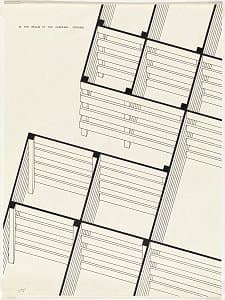

Robert Morris
Learn moreIn the realm of the carceral. Stockade 1978
Purchased 1980
More detail | PermalinkRobert Morris, one of the foremost American Minimalist artists, is best known for his geometric plywood sculptures. In December 1964, for his solo show at Green Gallery, New York, Morris exhibited a series of sculptures that were startlingly architectural in effect. Placed directly on the floor, across the corners of the space or suspended from the ceiling, these large, geometric, plywood forms were painted grey to have limited visual appeal and were, as Donald Judd commented at the time, ‘only barely present’.[1] Untitled (Corner beam), for example, was installed above a doorway and diagonally reached between two walls like a lintel, while Untitled (Corner piece) was set into the corner. These interconnected ‘units’ were, as Michael Desmond and Christine Dixon observe, ‘austere to the point of being aggressively abstract, and were plainly sculpture—architectural, yet distinct from architecture’.[2]
Two large drawings, part of a series of twelve and purchased at the time of Morris’ sculptures, indicate his broader interest in architectural issues. The use of axometric projection encourages the viewer to peer into the spaces and, perhaps, to question their purpose.[3] The ‘carceral’ of the title signals the artist’s concern with nexus between art and politics, a joining of formalism, mystical and historical allusion.[4] Further identified as a stockade and an ‘inmate work project’, Morris’ drawings are highly sculptural and, like Slab (platform) and Slab (cloud), seem to oscillate between two- and three-dimensions.
Lucina Ward
[1] Donald Judd, ‘Hartford,’ Arts Magazine 38, no 6, March 1964, and reprinted in Donald Judd: Complete writings 1959–1975, Press of the Novia Scotia College of Art and Design, Halifax, New York University Press, New York, 1975, p 117.
[2] Michael Desmond and Christine Dixon, 1968, National Gallery of Australia, Canberra, 1995, p 55.
[3] Morris’ use of carceral links his work to that of Michel Foucault: in Discipline and punish (1975), the French theorist's discussion of surveillance systems and their technologies includes the notion of a carceral archipelago or island prisons. A portfolio of ten etching and aquatints was issued by S & A Lithographic Plates, New York, in 1978-79.
[4] Stephen F Eisenmann, ‘The space of the self: Robert Morris, In the realm of the carceral’, Arts Magazine, September 1980, pp 104–109; see also Anaël Lejeune, ‘In the realm of the carceral. Robert Morris et le pouvoir disciplinaire,’ Marges vol 20, 2015, pp 29–43.

